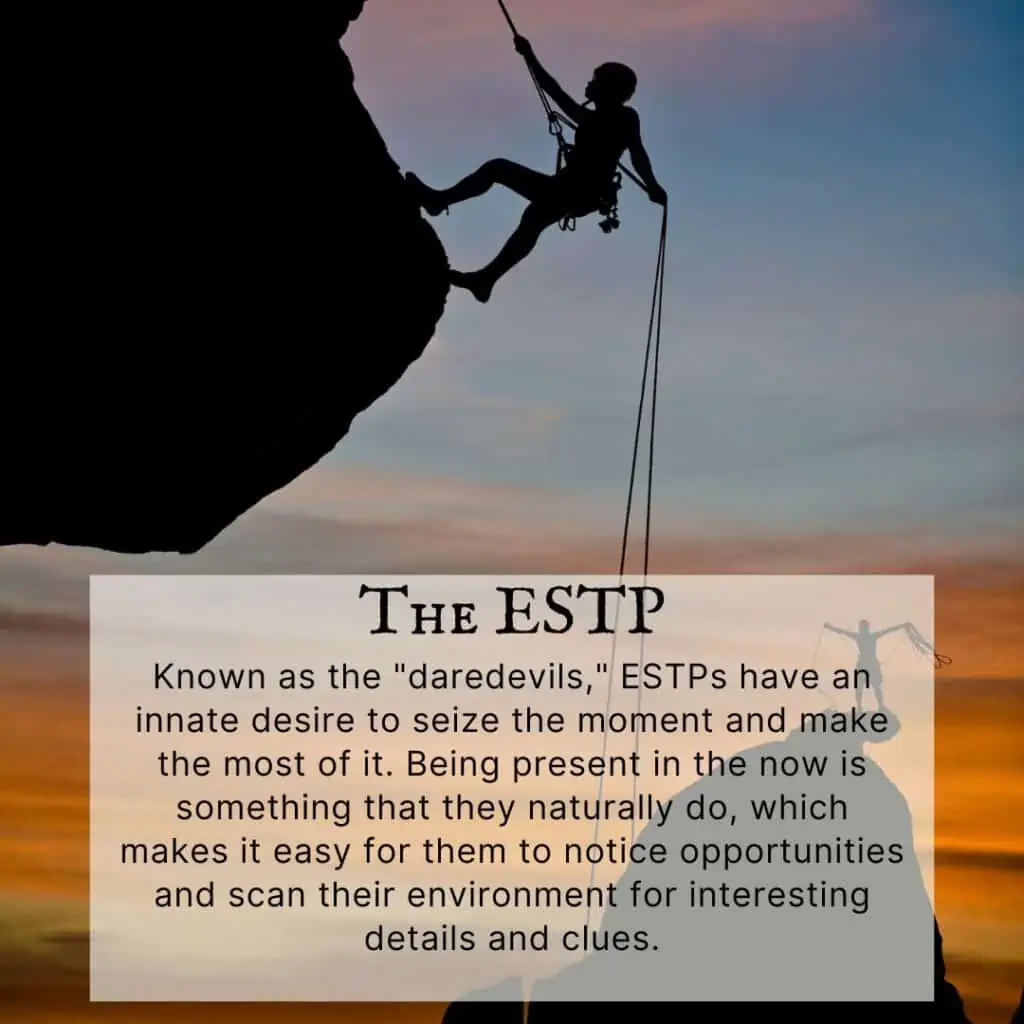10 Signs of an Unhealthy ESTP
Are you an ESTP personality type or do you know one? Maybe you’ve read a lot of online content about the personality type, but felt like something was missing.
Sometimes online content about Myers-Briggs personality types can be so praise-worthy that we lose the dimension of a person. Just as each personality type has a healthy side, they also have a dark or unhealthy side that can show up during moments of immaturity, stress, or one-sidedness. That’s what we’re going to be exploring today!

But first, what is an ESTP?
According to Myers-Briggs theory, ESTPs have the following preferences:
Extroversion: They focus primarily on the outer world and gain energy through interacting with it.
Sensation: Their perception is drawn to the tangible world that they can perceive with their senses.
Thinking: They analyze situations by looking at the impersonal criteria first in order to have a logical approach.
Perceiving: They enjoy a flexible, spontaneous approach to life rather than a regimented, planned-out approach.
Known as the “daredevils,” ESTPs have an innate desire to seize the moment and make the most of it. Being present in the now is something that they naturally do, which makes it easy for them to notice opportunities and scan their environment for interesting details and clues. At their best, ESTPs can be quick and rational, troubleshooting even the most alarming problems with a steady head. They are able to get right to the essence of an issue quickly and can easily see the relevant needs in a situation. At their worst, however, ESTPs can be reckless, impulsive, and hedonistic.
In today’s article we’re going to explore ten signs that an ESTP is in an unhealthy state. This could mean that they are one-sided, stressed, or immature. It could also mean they’re just having a bad day! For some of us, we can start the day on a healthy note only to make some unhealthy decisions later on.
Not sure what your personality type is? Take our personality questionnaire here. Or you can take the official MBTI® here.
The Unhealthy ESTP
Before we begin, let’s look at some of the ways someone can become unhealthy:
One-Sidedness:
Some people grow up prioritizing what comes naturally to them and avoiding anything that challenges them. They may look down on people who see the world differently or have different personality types, seeing the way they do things as inherently “wrong” or just plain annoying. This kind of a person can grow up to be one-sided; enjoying the parts of their personality they value and avoiding the parts of their personality that are less naturally appealing to them. These repressed parts of their personality can show up later as projections, paranoia, or “all or nothing” viewpoints.
Loops:
When a person is in a “loop” it means that they are favoring either the extroverted or introverted part of their personality to the exclusion of other parts. In the case of an ESTP, it could mean that they’re valuing their Extraverted Sensing and Extraverted Feeling cognitive functions, while repressing their Introverted Thinking and Introverted Intuitive functions. This can result in impulsiveness, people-pleasing, being manipulative, or making faulty, reckless decisions. You can find out more about loops here: What You’re Like in a Loop, Based On Your Myers-Briggs® Personality Type.
Stress:
Extreme or chronic stress can cause someone to lash out in unexpected ways. Sometimes during stress people behave more true-to-type or in an exaggerated way, trying to solve the problem by relying on their natural way of thinking. Other times they can fall into the grip of an uncharacteristic reaction called the “grip.” When this happens, they start behaving like their opposite type in challenging ways that confuse even them.
10 Signs of an Unhealthy ESTP:
#1 – They’re Self-Indulgent
Healthy ESTPs are in tune with the sensing and thinking sides of their personality. They enjoy experiencing life to the fullest, but they temper their desire for fun and excitement with a healthy dose of logic while weighing the pros and cons and likely effects. Unhealthy ESTPs, on the other hand, may go to extremes in their quest for sensation and fun. They may take unnecessary risks, engage in self-destructive behaviors, or be excessively indulgent. This can lead to problems with addiction or financial instability.
#2 – They’re Highly Reactive
Healthy ESTPs take time to size up a situation before reacting to it. Rather than trusting whatever impulse or emotion they’re feeling at the time, they look at the situation logically and also consider the perspectives of the people involved. ESTPs that are in a loop cycle back and forth between the Sensing and Feeling sides of their personality type, skipping past their more calm and analytical thinking side. When this happens, they become more emotionally reactive, more defensive, blaming, and possibly aggressive. Some ESTPs will instigate a fight just to get a rush while others will seek out approval or emotional exchanges of a more positive variety.
#3 – They Push the Limits
Many ESTPs, even healthy ones, have moments where they like to push the limits of what they can do. These types enjoy a challenge, especially if there’s an exciting reward at the end of it! But unhealthy ESTPs take this too far. They seek after the rush of excitement or reward without regard for the consequences. This can lead to dangerous or even life-threatening situations. For some ESTPs it leads to struggles with gambling, drinking, or overeating. For other ESTPS, it can lead to pushing themselves physically too hard and developing chronic pain as a result.
#4 – They’re Superficial
Healthy ESTPs have a healthy connection between the sensing and intuitive sides of their personality. While they prefer the world of the factual and concrete, they also recognize the importance of the intangible aspects of life. Areas like deeper meanings, imagination, foreseeing, and delving into more philosophical terrain. When ESTPs are unhealthy, they distrust anything that can’t be immediately felt with the senses. Rather than considering the weightier areas of life they focus on immediate enjoyments or superficial appearances. This can cause problems in ESTP’s relationships as well as in their ability to make decisions that take the long term into account.
#5 – They’re Manipulative
ESTPs are highly aware of their surroundings and the people in their vicinity. They have a knack for “reading” people and can quickly pick up on emotional cues and unspoken desires. When ESTPs are healthy, they use this ability to build rapport with others and create win-win situations. Unhealthy ESTPs, on the other hand, may use their skills of perception and persuasion to manipulate those around them. They may convince people to do things they don’t want to do or give them false information in order to get what they want. This can lead to problems in ESTP’s personal and professional relationships.
#6 – They’re Inconsistent
ESTPs are known for their ability to adapt to changing circumstances. They’re quick thinkers and often come up with creative solutions on the fly. This flexibility is a strength, but it can also be a weakness. Unhealthy ESTPs may be so busy chasing after new opportunities and experiences that they never stick with anything for long. They may start projects or relationships and then abandon them when things get tough or they get bored. This inconsistency can be frustrating for those around them and can make it difficult for them to achieve any of their long-term goals.
#7 – They’re Paranoid
Not all unhealthy ESTPs are paranoid, but some are. Paranoia often shows up when ESTPs are in the grip of their inferior function, Introverted Intuition. During cases of extreme or chronic stress, ESTPs may start behaving in ways that are foreign to them or the people who know them. Rather than being pragmatic and collected, they suddenly become fixated on future implications and all the things that could go wrong. Everything starts to feel bleak and ominous to them and they fixate on abstract impressions rather than the details and facts that they usually look to. This especially happens if ESTPs have been repressing their intuitive side for too long. Healthy ESTPs should balance their love of sensory enjoyment and facts with some quiet time for reflection and “daydreaming.” Having some time to dive into the more imaginative or aspects of life can help prevent ESTPs from repressing their intuition and having it bubble up at another time in an unhealthy way.
#8 – They Make Careless Mistakes
Healthy ESTPs are in touch with the thinking side of their personality and take time to plan ahead, even if it’s just a little bit. Even if they prefer other things, they’ve developed a patience with the mundane maintenance aspects of life. This can show up like paying their taxes on time, flossing their teeth, and/or making necessary contingency plans.
Unhealthy ESTPs, in contrast, tend to think from moment to moment and despise planning ahead. They also dislike anything that is remotely mundane and will avoid it if they can. This can lead to them making careless decisions or seeming flighty and irresponsible to the people around them.
#9 – They Lack Imagination
Healthy ESTPs are not only realists, they also value the fun and creativity of the imagination. While they’re more about what’s real than what’s imagined, they still infuse their projects with creative flourishes imagined in their mind. They take time to imagine how other people would perceive things in order to have more empathetic responses to things. Unhealthy ESTPs lack appreciation for this quality; they tend to distrust anything that isn’t tangible and observable. Because of this, they may lack originality or struggle to empathize with other peoples’ situations and feelings.
#10 – They Avoid Commitment
ESTPs live for new experiences and are always seeking out novelty. This can make them seem fickle or flighty to others, but it doesn’t necessarily mean that they’re avoidant of commitment. In fact, ESTPs can be very loyal and committed when they find something (or someone) that they really care about. However, unhealthy ESTPs may have a hard time committing to anything long-term. They may start projects or relationships and then abandon them when things get tough or they get bored. When relationships start to get serious they can immediately feel trapped and look for a way out.
Self-Help Tips for ESTPs:
Becoming a healthy ESTP means both taking care of yourself and challenging yourself. A stressed ESTP who’s always overwhelmed is going to struggle to be healthy. If you’re a stressed ESTP, taking time to rest, write down your thoughts, or check in with your physical needs would be crucial.
If you’re a one-sided ESTP, then getting healthy means challenging yourself with sides of yourself you don’t normally tap into.
Take time to analyze the roots of your beliefs; why do you believe them? Are they true?
Think critically about the decisions you make. What are the consequences of your decisions? How do other people see things? Talk to someone who disagrees with you about an important issue and try to see their side. Interact with a wide variety of people who share different views.
Read articles that challenge your perspectives. Don’t accept what they say without question; but think critically about your beliefs as well as the ones you’re reading about.
Get down to the truth – what is it? Take time to be alone, even if you feel restless and anxious to do something. Meditate, rest, or write down your thoughts. You might find yourself making wiser decisions, becoming more careful, and getting more helpful insights as a result.
If you feel restless and impulsive, take time to breathe and slow yourself down. Examine the facts, the consequences, and the logic of your decision. Do the same when you’re considering abandoning a project or commitment you once cared about.
What Are Your Thoughts?
Do you have anything to add? Let us know in the comments! At their best, ESTPs can be some of the most clever, ingenious, and competent people you’ll meet. If you’re reading this article and thinking that all ESTPs are like this, I want to assure you that it couldn’t be further from the truth. This article describes what they’re like at their worst or on their really bad days. A lot of people in the type community like to judge people of other types and I don’t want anyone to use this article to contribute to that.
Find out more about your personality type in our eBooks, Discovering You: Unlocking the Power of Personality Type, The INFJ – Understanding the Mystic, The INTJ – Understanding the Strategist, and The INFP – Understanding the Dreamer. You can also connect with me via Facebook, Instagram, or Twitter!











